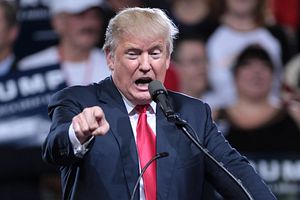U.S. President Donald Trump has not yet officially labeled China a currency manipulator, despite promising to do so on his first day in office. This is not due to a change of heart, as evidenced by his recent referral to China as the “grand champions” of currency manipulation. So why hasn’t he acted on the manipulation charges he levied against China during the campaign, as well as those against Korea and Japan?
Most of Trump’s international economic advisers and cabinet picks share his views on currency manipulation, particularly Wilbur Ross at the Department of Commerce and Peter Navarro, head of the new National Trade Council. The notable exception is Treasury Secretary Steven Mnuchin. At every possible opportunity Mnuchin has distanced himself from the president’s rhetoric by supporting the established review procedures to determine if China manipulates its currency, insinuating a commitment to the same fundamental economic principles that have led many to counter Trump’s arguments on this issue. While Trump’s sentiments are drowning out those of his treasury secretary — look no further than recent Japanese and Korean consternation over potentially receiving the unwanted label — Mnuchin’s outlook and the legal process for naming a manipulator are key to understanding why the president has not translated rhetoric into action.
Under the Trade Facilitation and Trade Enforcement Act of 2015, it is the responsibility of the U.S. Treasury Department — not the president himself — to gauge if a trading partner is manipulating its currency. With respect to individual partners, the law sets out criteria for Treasury to track: “(1) a significant bilateral trade surplus with the United States, (2) a material current account surplus, and (3) engaged in persistent one-sided intervention in the foreign exchange market.” If a country meets all three criteria, Treasury is required to declare it a currency manipulator in its biannual reports to Congress in April or October, though it has flexibility in how these criteria are interpreted.
During the Obama administration, Treasury defined the three corresponding criteria as: (1) a bilateral trade surplus of $20 billion, (2) a current account surplus larger than 3 percent of GDP, and (3) repeated net purchases of foreign currency more than 2 percent of GDP over the previous 12 months. Korea and Japan meet the first and second criteria, along with four other countries. China only meets the first. However, none will meet all three requirements in April, unless Treasury’s criteria are changed.
While it is possible Trump instructed Mnuchin to lower these thresholds to go after China in April, it would not allow for surgical precision. Altering the above criteria would create collateral damage for the five other countries currently on Treasury’s watch list, including Japan and Korea. Defense Secretary Jim Mattis’ first overseas trip to Korea and Japan as well as the complete reversal of Trump’s inflammatory campaign statements toward each crucial regional ally indicate the administration would not deliberately target either. It also strongly suggests the administration would not risk souring relationships with both Seoul and Tokyo to go after China on currency policy — which is itself improbable as evidenced by Mnuchin’s reluctance to back Trump’s rhetoric, productive first call with his counterpart in Beijing, and support for a strong dollar.
After being singled out in the recent U.S. Trade Representative Trade Policy Agenda, some Koreans may be skeptical of their security relationship factoring into the administration’s economic calculations. Yet, with such a blunt tool, if Treasury targeted Korea it would also target Japan, scuttling Trump’s budding relationship with Prime Minister Shinzo Abe along with hopes for a U.S.-Japan FTA.
Even in the highly unlikely case of the U.S. naming a currency manipulator in April, the process outlined by Congress would not allow the president to pursue the highly punitive measures he asserted during his campaign, such as a 45 percent tariff on Chinese imports. After labeling a manipulator, Treasury is required to first engage in bilateral talks to work out a solution. Only after a year has passed and the offender has not made progress to rectify the issue can the administration take up to four legally outlined remedial actions against the other party.
Though the law does allow for a waiver on talks, it can only be pursued by Mnuchin — not Trump — if he deems national security to be at stake or if it would be in Washington’s best interest. If Mnuchin waived talks for either reason he would need to issue a public report to Congress defending his determination. This is a difficult argument to make for China and an impossible one for Korea and Japan due to their strategic importance. Security ties and Washington’s knowledge that factors potentially indicative of currency manipulation for each ally are rooted in stubborn structural economic issues would make it difficult for triggered bilateral dialogues to be anything more than symbolic. However, the cabinet members required to sign off on the choices that would ultimately result in forced talks are not interested in getting to such a point in the first place.
Although Trump may find it easier to move on his currency manipulation charges through other means, these would be considerably less effective in achieving the scope of his goals. Checks on Trump even within his own administration help to ground policy in evidence-based decisions, but uncertainty in the interim is highly detrimental to both markets and bilateral relations. Concerned Asian trading partners, particularly China and Korea, would be wise not to correlate the intensity of Trump’s “bark” on currency manipulation with his “bite,” provided it continues to not be supported by economic data.
Kyle Ferrier is the Director of Academic Affairs and Research at the Korea Economic Institute of America. The views expressed here are the author’s alone.

































